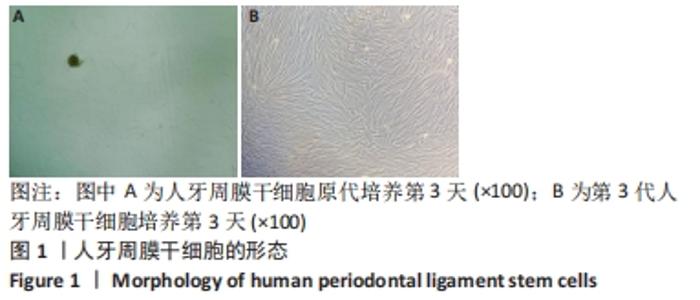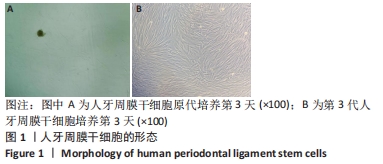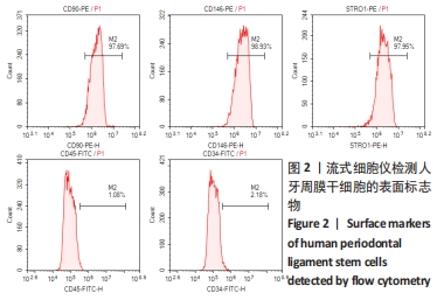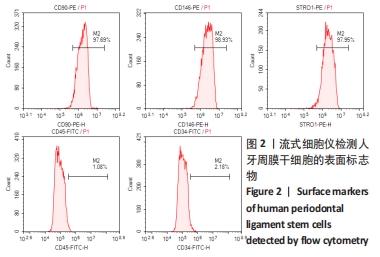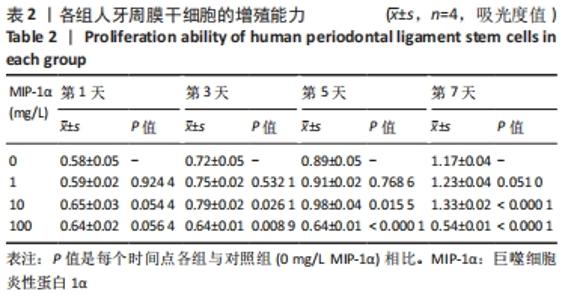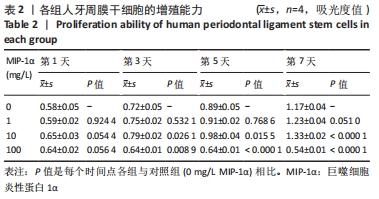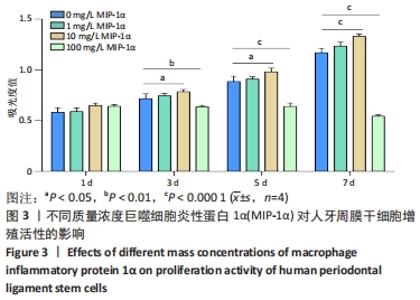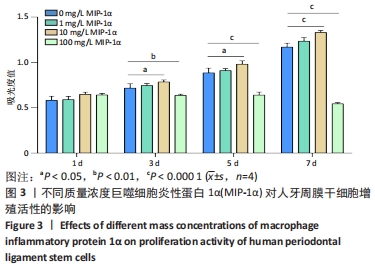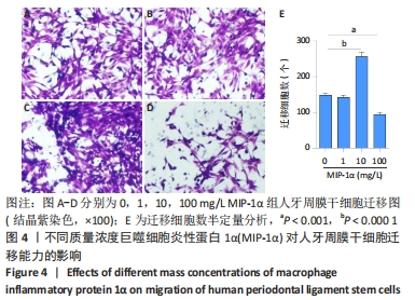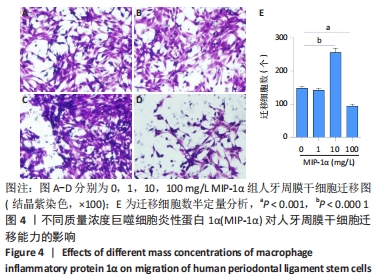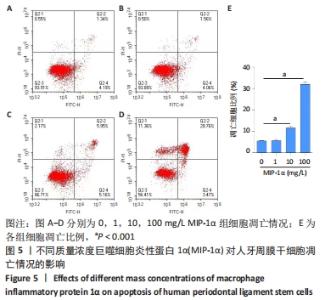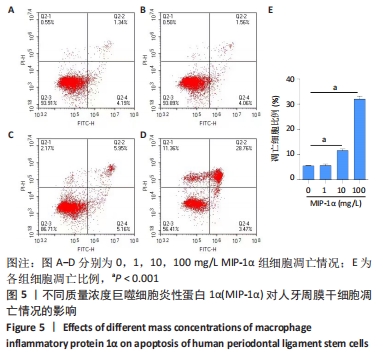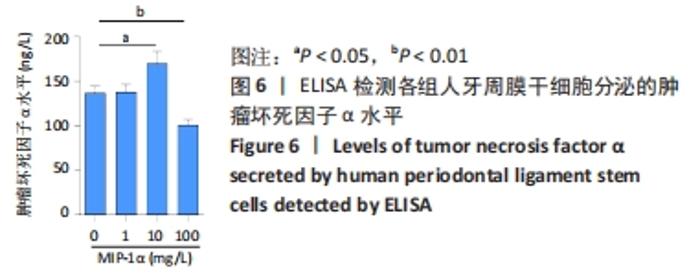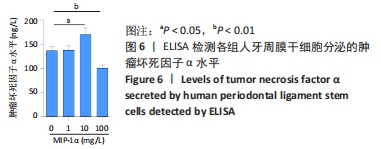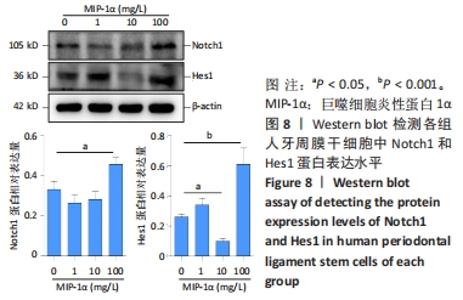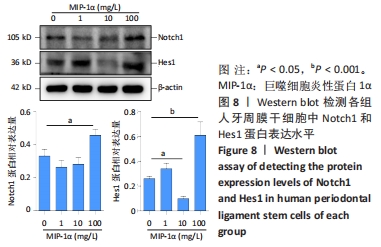Chinese Journal of Tissue Engineering Research ›› 2023, Vol. 27 ›› Issue (10): 1521-1527.doi: 10.12307/2023.284
Previous Articles Next Articles
Effect of macrophage inflammatory protein-1 alpha on the biological behavior of human periodontal ligament stem cells
Wang Zhaoxin, Nijati•Tursun, Dai Huijuan, Wang Junxiang, Xiaheida•Yilaljiang, Li Shuhui
- Department of Stomatology, Second Affiliated Hospital of Xinjiang Medical University, Urumqi 830063, Xinjiang Uygur Autonomous Region, China
-
Received:2022-03-04Accepted:2022-05-20Online:2023-04-08Published:2022-09-08 -
Contact:Li Shuhui, MD, Associate chief physician, Department of Stomatology, Second Affiliated Hospital of Xinjiang Medical University, Urumqi 830063, Xinjiang Uygur Autonomous Region, China -
About author:Wang Zhaoxin, Master candidate, Department of Stomatology, Second Affiliated Hospital of Xinjiang Medical University, Urumqi 830063, Xinjiang Uygur Autonomous Region, China -
Supported by:Science Foundation of Xinjiang Uygur Autonomous Region, No. 2019D01C231 (to LSH)
CLC Number:
Cite this article
Wang Zhaoxin, Nijati•Tursun, Dai Huijuan, Wang Junxiang, Xiaheida•Yilaljiang, Li Shuhui. Effect of macrophage inflammatory protein-1 alpha on the biological behavior of human periodontal ligament stem cells[J]. Chinese Journal of Tissue Engineering Research, 2023, 27(10): 1521-1527.
share this article
Add to citation manager EndNote|Reference Manager|ProCite|BibTeX|RefWorks
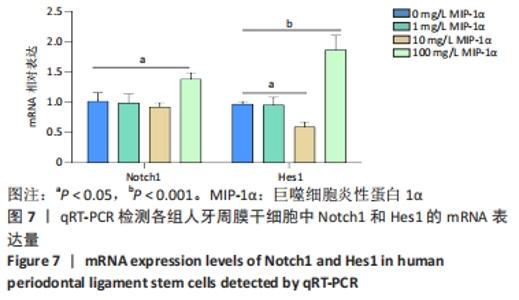
2.7 qRT-PCR检测各组人牙周膜干细胞中Notch1和Hes1的mRNA表达量 在MIP-1α处理48 h后,1 mg/L MIP-1α组Notch1、Hes1 mRNA表达量与对照组相比无显著差异(P > 0.05);10 mg/L MIP-1α组Notch1的mRNA表达量与对照组相比无显著差异(P > 0.05),但Notch通路下游基因Hes1的mRNA表达量显著低于对照组(P < 0.01);100 mg/L MIP-1α 上调通路受体Notch1的mRNA表达,显著高于对照组(P < 0.05),上调通路下游基因Hes1的mRNA表达,显著高于对照组(P < 0.01),见图7。"
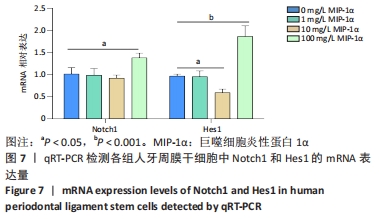
| [1] KWON T, LAMSTER IB, LEVIN L. Current Concepts in the Management of Periodontitis. Int Dent J. 2021;71(6):462-476. [2] LÓPEZ R, SMITH PC, SCHWENDICKE F, et al. Ageing, dental caries and periodontal diseases. J Clin Periodontol. 2017;44 Suppl 18:S145-S152. [3] LAUDENBACH JM, KUMAR SS. Common Dental and Periodontal Diseases. Dermatol Clin. 2020;38(4):413-420. [4] DANNEWITZ B, HOLTFRETER B, EICKHOLZ P. Periodontitis-therapy of a widespread disease. Bundesgesundheitsblatt Gesundheitsforschung Gesundheitsschutz. 2021;64(8):931-940. [5] ELANGOVAN S, PRAKASAM S, GAJENDRAREDDY P, et al. A Risk of Bias Assessment of Randomized Controlled Trials (RCTs) on Periodontal Regeneration Published in 2013. J Evid Based Dent Pract. 2016;16(1):30-40. [6] YUANZHENG C, YAN G, TING L, et al. Enhancement of the repair of dog alveolar cleft by an autologous iliac bone, bone marrow-derived mesenchymal stem cell, and platelet-rich fibrin mixture. Plast Reconstr Surg. 2015;135(5):1405-1412. [7] LU J, HAO Y, ZHAO W, et al. Molecular, Cellular and Pharmaceutical Aspects of Autologous Grafts for Peri-implant Hard and Soft Tissue Defects. Curr Pharm Biotechnol. 2017;18(1):85-94. [8] CHALISSERRY EP, NAM SY, ANIL S, et al. Therapeutic potential of dental stem cells. J Tissue Eng. 2017;8:2041731417702531. [9] FENG F, AKIYAMA K, SHI S, et al. Utility of PDL progenitors for in vivo tissue regeneration: a report of 3 cases. Oral Dis. 2010;16(1):20-28. [10] LIU Y, ZHENG Y, WANG S, et al. Periodontal ligament stem cell-mediated treatment for periodontitis in miniature swine. Stem Cells. 2008;26(4):1065-1073. [11] CHEN FM. Periodontal tissue engineering and regeneration. Zhonghua Kou Qiang Yi Xue Za Zhi. 2017;52(10):610-614. [12] 贺钧,李自良,谢志刚.骨替代材料的骨诱导性能研究进展[J].口腔疾病防治,2018,26(2):124-127. [13] SUN Q, NAKATA H, YAMAMOTO M, et al. Comparison of gingiva-derived and bone marrow mesenchymal stem cells for osteogenesis. J Cell Mol Med. 2019;23(11):7592-7601. [14] WANG X, ZOU X, ZHAO J, et al. Site-Specific Characteristics of Bone Marrow Mesenchymal Stromal Cells Modify the Effect of Aging on the Skeleton. Rejuvenation Res. 2016;19(5):351-361. [15] HASSAN NT, ABDELAZIZ NA. Oral Mucosal Stem Cells, Human Immature Dental Pulp Stem Cells and Hair Follicle Bulge Stem Cells as Adult Stem Cells Able to Correct Limbal Stem Cell Deficiency. Curr Stem Cell Res Ther. 2018;13(5):356-361. [16] BOLLERO P, PASSARELLI PC, D’ADDONA A, et al. Oral management of adult patients undergoing hematopoietic stem cell transplantation. Eur Rev Med Pharmacol Sci. 2018;22(4):876-887. [17] 李晓明,袁长永,王鹏来,等.牙源性干细胞在牙槽骨再生领域的研究进展[J].口腔医学,2017,37(8):755-759. [18] 李晓钰,王红,魏福兰,等.年龄因素对牙周膜干细胞多向分化能力的影响[J].口腔生物医学,2019,10(2):78-82. [19] WANG P, WANG W, YUAN C, et al. EphrinB2 regulates osteogenic differentiation of periodontal ligament stem cells and alveolar bone defect regeneration in beagles. J Tissue Eng. 2019;10: 2041731419894361. [20] SEO BM, MIURA M, GRONTHOS S, et al. Investigation of multipotent postnatal stem cells from human periodontal ligament. Lancet. 2004 ;364(9429):149-155. [21] PALOMINO DC, MARTI LC. Chemokines and immunity. Einstein (Sao Paulo). 2015;13(3):469-473. [22] 于雅琼,李晓琳,郭艳,等.牙髓卟啉单胞菌脂多糖对小鼠成骨细胞表达MIP-1α的影响[J].上海口腔医学,2017,26(3):263-267. [23] 贾搏,邱小玲,赵建江,等.巨噬细胞炎症蛋白-1β对人舌鳞癌细胞CAL-27增殖和凋亡的影响[J].南方医科大学学报,2017,37(8): 1104-1109. [24] KAM YW, AHMED MY, NG LF, et al. Systematic analysis of disease-specific immunological signatures in patients with febrile illness from Saudi Arabia. Clin Transl Immunology. 2020;9(8):e1163. [25] LI JS, FAN LY, XING MY, et al. Salidroside Inhibits Lipopolysaccharide-ethanol-induced Activation of Proinflammatory Macrophages via Notch Signaling Pathway. Curr Med Sci. 2019;39(4):526-533. [26] 马玉,李淑慧,吴佩玲,等.肿瘤坏死因子-α对牙周膜干细胞骨向分化及Notch信号通路的影响[J].华西口腔医学杂志,2018,36(2): 184-189. [27] NOORI A, ASHRAFI SJ, VAEZ-GHAEMI R, et al. A review of fibrin and fibrin composites for bone tissue engineering. Int J Nanomedicine. 2017;12:4937-4961. [28] 毕雪婷,申玉芹,林崇韬,等.寡核苷酸YW002对人牙周膜干细胞增殖、周期、凋亡和早期成骨分化的影响[J].吉林大学学报(医学版),2019,45(2):273-279. [29] SUI BD, HU CH, JIN Y, et al . Stem cell-based bone regeneration in diseased microenvironments: Challenges and solutions. Biomaterials. 2019;196:18-30. [30] ZHAO H, FENG J, CHAI Y, et al. Secretion of shh by a neurovascular bundle niche supports mesenchymal stem cell homeostasis in the adult mouse incisor. Cell Stem Cell. 2014;14(2):160-173. [31] ZHENG CX, SUI BD, JIN Y, et al. Adipose mesenchymal stem cells from osteoporotic donors preserve functionality and modulate systemic inflammatory microenvironment in osteoporotic cytotherapy. Sci Rep. 2018;8(1):5215. [32] 王仁兰.MCP-1和MIP-1α在牙龈炎和牙周炎患者体液中的表达水平及意义[J].中国实验诊断学,2021,25(10):1476-1479. [33] 田萧羽,杨烁,温宁,等.炎症微环境中脐带干细胞外泌体对牙周膜干细胞增殖和迁移的影响[J].解放军医学院学报,2021,42(5): 541-547,554. [34] 何滢,杨印祥,栾佐,等.肿瘤坏死因子α(TNF-α)体外抑制人少突胶质细胞前体细胞的迁移[J].细胞与分子免疫学杂志,2021,37(7): 585-589. [35] BAIK HS, PARK J, CHUNG C, et al. Local application of periodontal ligament stromal cells promotes soft tissue regeneration. Oral Dis. 2014;20(6):574-581. [36] DU J, SHAN Z, FAN Z, et al. Allogeneic bone marrow mesenchymal stem cell transplantation for periodontal regeneration. J Dent Res. 2014;93(2):183-188. [37] 丁广存.基础治疗对牙周炎患者血清及龈沟中炎症因子及趋化因子的影响[J].齐齐哈尔医学院学报,2018,39(11):1295-1297. [38] 刘继刚,刘昊.慢性牙周炎患者龈沟液中MIP-1α和TNF-α的变化[J].牙体牙髓牙周病学杂志,2016,26(8):495-497. [39] ĐORĐEVIĆ IO, KUKOLJ T, KRSTIĆ J, et al. The inhibition of periodontal ligament stem cells osteogenic differentiation by IL-17 is mediated via MAPKs. Int J Biochem Cell Biol. 2016;71:92-101. [40] 赵刚,段序,王丹,等.Notch信号通路对大鼠牙囊细胞增殖和成骨分化的调控作用[J].北京口腔医学,2021,29(5):271-275. [41] WU Y, GAO Q, FENG S, et al. Low-intensity pulsed ultrasound regulates proliferation and differentiation of neural stem cells through notch signaling pathway. Biochem Biophys Res Commun. 2020;526(3):793-798. [42] LI Y, LI SQ, ZHANG B, et al. Crucial role of Notch signaling in osteogenic differentiation of periodontal ligament stem cells in osteoporotic rats. Cell Biol Int. 2014;38(6):729-736. [43] DÍAZ-TOCADOS JM, HERENCIA C, MUÑOZ-CASTAÑEDA JR, et al. Magnesium Chloride promotes Osteogenesis through Notch signaling activation and expansion of Mesenchymal Stem Cells. Sci Rep. 2017; 7(1):7839. [44] 朱永翠,翟蕾,李亚如,等.过表达ADAM10通过调控Notch信号通路对牙周膜干细胞成骨分化的影响[J].口腔医学研究,2021, 37(5):468-473. [45] OSATHANON T, RITPRAJAK P, PAVASANT P, et al. Surface-bound orientated Jagged-1 enhances osteogenic differentiation of human periodontal ligament-derived mesenchymal stem cells. J Biomed Mater Res A. 2013;101(2):358-367. |
| [1] | Fang Xingyan, Tian Zhenli, Zhao Zheyi, Wen Ping, Xie Tingting. Effects of sodium arsenite on human umbilical vein endothelial cell injury and sphingosine kinases 1/sphingosine 1-phosphate signaling axis [J]. Chinese Journal of Tissue Engineering Research, 2023, 27(在线): 1-7. |
| [2] | Nie Chenchen, Su Kaiqi, Gao Jing, Fan Yongfu, Ruan Xiaodi, Yuan Jie, Duan Zhaoyuan, Feng Xiaodong. The regulatory role of circular RNAs in cerebral ischemia-reperfusion injury [J]. Chinese Journal of Tissue Engineering Research, 2023, 27(8): 1286-1291. |
| [3] | Liu Xiaolin, Mu Xinyue, Ma Ziyu, Liu Shutai, Wang Wenlong, Han Xiaoqian, Dong Zhiheng. Effect of hydrogel-loaded simvastatin microspheres on osteoblast proliferation and differentiation [J]. Chinese Journal of Tissue Engineering Research, 2023, 27(7): 998-1003. |
| [4] | Cui Lianxu, Jiang Wenkang, Lu Dahong, Xu Junrong, Liu Xiaocui, Wang Bingyun. Clinical-grade human umbilical cord mesenchymal stem cells affect the improvement of neurological function in rats with traumatic brain injury [J]. Chinese Journal of Tissue Engineering Research, 2023, 27(6): 835-839. |
| [5] | Li Qicheng, Deng Jin, Fu Xiaoyang, Han Na. Effects of bone marrow mesenchymal stem cells-derived exosomes on hypoxia-treated myoblasts [J]. Chinese Journal of Tissue Engineering Research, 2023, 27(6): 853-859. |
| [6] | Qiao Luhui, Ma Ziyu, Guo Haoyu, Hou Yudong. Comparison of puerarin and icariin on the biological properties of mouse preosteoblasts [J]. Chinese Journal of Tissue Engineering Research, 2023, 27(6): 872-877. |
| [7] | Hao Liufang, Duan Hongmei, Wang Zijue, Hao Fei, Hao Peng, Zhao Wen, Gao Yudan, Yang Zhaoyang, Li Xiaoguang. Spatiotemporal dynamic changes of ependymal cells after spinal cord injury in transgenic mice [J]. Chinese Journal of Tissue Engineering Research, 2023, 27(6): 883-889. |
| [8] | Zhao Siqi, Du Juan, Qu Haifeng, Li Jianmin, Zhang Yuxin, Liu Junjie. Effects of enriched environment combined with melatonin on learning and memory function and brain neuron apoptosis in SAMP8 mice [J]. Chinese Journal of Tissue Engineering Research, 2023, 27(5): 701-706. |
| [9] | Zhang Qing, Gao Chunlan, Yu Feifei, Zhang Zhenghao, Ma Fang, Gao Yuan, Li Guizhong, Jiang Yideng, Ma Shengchao. Ephrin A receptor 2 DNA methylation increases in pancreatic beta cell apoptosis induced by homocysteine [J]. Chinese Journal of Tissue Engineering Research, 2023, 27(5): 714-719. |
| [10] | Li Long, Li Guangdi, Shi Hao, Deng Keqi. Circular RNA as a competing endogenous RNA is involved in the regulation of osteoarthritis [J]. Chinese Journal of Tissue Engineering Research, 2023, 27(5): 751-757. |
| [11] | Li Zhichao, Tan Guoqing, Su Hui, Xu Zhanwang, Xue Haipeng. Regulatory role of non-coding RNAs as potential therapeutic targets in spinal cord injury [J]. Chinese Journal of Tissue Engineering Research, 2023, 27(5): 758-764. |
| [12] | Wu Shuangshuang, Zhang Ying, Kou Xianjuan. Treadmill exercise improves cognitive dysfunction in diabetic rats [J]. Chinese Journal of Tissue Engineering Research, 2023, 27(2): 208-215. |
| [13] | Ou Hangjun, Zhao Guangjian, Pan Yujia, Gong Caiwei, Zhao Quanwei, Liu Danan. Construction of a lentiviral vector overexpressing fibronectin type III domain containing 5 to inhibit apoptosis of endothelial cells [J]. Chinese Journal of Tissue Engineering Research, 2023, 27(2): 216-222. |
| [14] | Wang Huanhuan, Wang Qing, Tang Peng, Zhang Rui, Min Hongwei. Effects of extracorporeal shock wave on the proliferation and autophagy of chondrocytes from osteoarthritis rats [J]. Chinese Journal of Tissue Engineering Research, 2023, 27(2): 252-257. |
| [15] | Diao Xiaojuan, Shi Chaoqun, Li Dong, Wang Shuai, Xiao Chun, Liu Guojun, Qu Tingyu, Yang Weijuan, Jia Xiaopeng. Efficient expansion of natural killer cells from cryopreserved umbilical cord blood by pure cytokine method without animal ingredients [J]. Chinese Journal of Tissue Engineering Research, 2023, 27(10): 1572-1577. |
| Viewed | ||||||
|
Full text |
|
|||||
|
Abstract |
|
|||||
